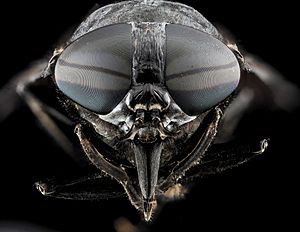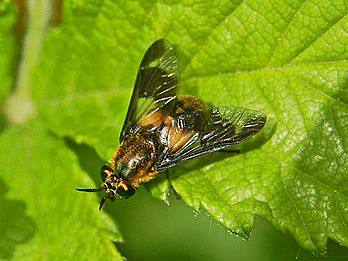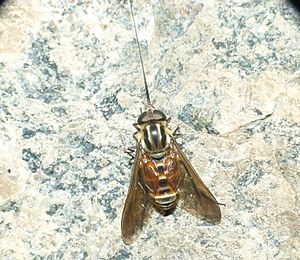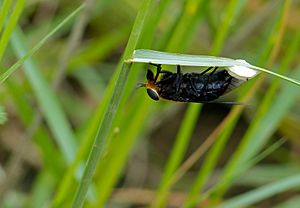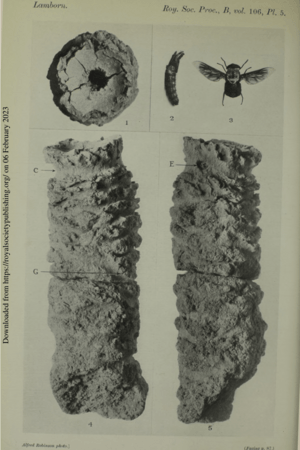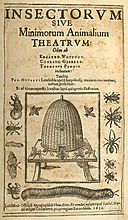Tabanidae facts for kids
Quick facts for kids Tabanidae |
|
|---|---|
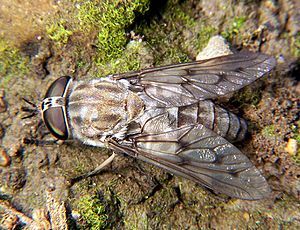 |
|
| Tabanus sulcifrons | |
| Scientific classification |
|
| Kingdom: | Animalia |
| Phylum: | Arthropoda |
| Class: | Insecta |
| Order: | Diptera |
| Superfamily: | Tabanoidea |
| Family: | Tabanidae Latreille, 1802 |
| Subfamilies | |
|
|
Horse-flies and deer flies are types of true flies. They belong to the family Tabanidae. These insects are part of the insect order called Diptera. Adult horse-flies are often big and can fly very fast. Only female horse-flies bite animals, including humans. They do this to get blood, which they need to make eggs. Horse-flies like to fly in sunlight. They avoid dark, shady places and are not active at night. You can find them almost everywhere in the world. They are not found on some islands or in very cold polar regions.
Adult horse-flies eat nectar and plant juices. Male horse-flies have weak mouthparts and cannot bite. Female horse-flies need blood to get enough protein for their eggs. Their mouthparts are like a strong stabbing tool. It has two sharp cutting blades. There is also a spongy part to soak up the blood. Horse-fly larvae are predators. They grow in wet or semi-wet places.
Female horse-flies can spread blood-borne diseases. They do this when they bite different animals. They have been known to carry diseases like equine infectious anaemia virus. They can also carry some trypanosomes and the filarial worm Loa loa. Horse-flies can also spread anthrax among cattle and sheep. They can also spread tularemia. If animals like cattle are bitten a lot, they might not grow well. Cows might also produce less milk.
Horse-flies have been mentioned in old stories. The ancient Greek writer Aeschylus wrote about them. He said they could drive people to "madness" because they kept bothering them.
Contents
What are Horse-Flies Called?

Tabanidae have many different common names. The group called Chrysopsinae is known as deer flies. This might be because they are common where deer live. Other names like buffalo-flies or elephant-flies come from places where those animals are found. The name horse fly usually refers to Tabaninae. These flies are typically bigger and stronger. They also do not have the striped wings that deer flies have. Other common names include tabanids, gadflies, and green-headed flies.
The word "Tabanus" was first used by Pliny the Younger. It is still used today as a scientific name. In the past, people often called all biting insects that bothered their cattle "gad-flies." The word "gad" means a spike. Other names like "cleg" or "gleg" come from Old Norse. These names might have come from the Vikings. Names like "stouts" describe their wide bodies. "Dun-flies" refers to their dull colors. In Australia and the UK, they are also called March flies.
What Do Horse-Flies Look Like?
Adult tabanids are large flies. They have big compound eyes. Their antennae are short and have three parts. Their bodies are wide. Female flies have eyes that are far apart. Male flies have eyes that are almost touching. Their eyes are often colorful when they are alive. The last part of the antennae is pointed. It looks like it is made of several rings.
Both the head and body have short hairs. But there are no stiff bristles on their bodies. Their front wings are thin and clear. They can be gray, brown, or have patterns. They have a small lobe that covers their small, knob-like hindwings. The tips of their legs have two side lobes. They also have a central lobe and two claws. These help them grip surfaces. Scientists tell different species apart by looking at their heads. They also look at wing patterns and body colors.
Horse-fly species can be medium to very large insects. Most are between 5 and 25 mm (0.2 and 1.0 in) long. The biggest ones can have a wingspan of 60 mm (2.4 in). Deer flies (genus Chrysops) are up to 10 mm (0.4 in) long. They have yellow to black bodies and striped bellies. Their wings have dark patches. Horse-flies (genus Tabanus) are larger, up to 25 mm (1 in) long. They are mostly dark brown or black. Their eyes are dark and often look shiny. Yellow flies (genus Diachlorus) look like deer flies. But they have yellowish bodies. Their eyes are purplish-black with a green shine. Some species have a very long proboscis (a tube-like mouthpart).
Horse-fly larvae are long and shaped like a cylinder. They have small heads and 12 body parts. They have rings of small bumps called pseudopods. They also have bands of short bristles. The back end of each larva has a breathing tube. It also has a round area called Graber's organ. You can see the shape of the adult fly's head and wings through the pupa. The pupa has seven moving body parts. Each part has a band of bristles. The back end of the pupa has a group of spine-like bumps.
Some species, like deer flies, are very noisy when they fly. But others, like clegs, fly quietly. They can bite without much warning. Tabanids are fast and skillful fliers. Some species can do amazing turns in the air. Male Hybomitra hinei wrighti horse-flies have been recorded flying up to 145 kilometres per hour (90 mph). This happens when they are chasing a female.
Where Do Horse-Flies Live?
Horse-flies are found all over the world. They are not in the polar regions. They are also missing from some islands like Greenland, Iceland, and Hawaii. The groups Tabanus, Chrysops, and Haematopota live in many different climates. These include warm, mild, and tropical places. However, Haematopota is not found in Australia or South America. Horse-flies mostly live in warm areas. They need wet places for their young to grow. But they can live in many habitats. These range from deserts to high mountain meadows. You can find them from sea level up to at least 3,300 m (10,800 ft).
How Horse-Flies Evolved
The oldest horse-fly fossils are from the Early Cretaceous period. This was about 145–140 million years ago. The first known fossil is Eotabanoid. Its wings were found in England. Even if an ancient insect had a long mouthpart, it might not have sucked blood. It could have eaten nectar instead. Early horse-flies might have evolved along with flowering plants. They probably ate plants. To make eggs, females need a lot of protein. So, the first horse-flies might have been predators. From this, the habit of sucking blood might have developed.
In Brazil, fossils of horse-flies have been found. No mammal fossils were found with them. So, those ancient horse-flies likely fed on reptiles. Sucking blood from cold-blooded animals probably came before warm-blooded ones. But some dinosaurs might have been warm-blooded. They could have been early hosts for horse-flies.
Horse-flies are "true flies." They are part of the insect order Diptera. The Tabanidae family is grouped with other families. These include Athericidae, Pelecorhynchidae, and Oreoleptidae. They are all in the superfamily Tabanoidea. This group is part of the infraorder Tabanomorpha. These families seem to share a common feature. Their larvae have a venom canal in their jaw. Around the world, about 4,455 species of Tabanidae have been found. Over 1,300 of these are in the group Tabanus.
Scientists identify tabanids mostly by how the adults look. They check their heads, wing veins, and sometimes the last part of their body. In the past, the family was divided into three main groups: Pangoniinae, Chrysopsinae, and Tabaninae. Some scientists added two more groups: Adersiinae and Scepsidinae.
A study in 2015 looked at their DNA. It helped to understand the family tree of Tabanidae. This study supported having three main groups. The groups Pangoniinae and Tabaninae were confirmed as distinct. The study also showed that some smaller groups were distinct.
The Tabaninae group does not have ocelli (simple eyes). They also do not have spurs on their back legs. In the Pangoniinae group, ocelli are present. Their antennae usually have eight rings. In the Chrysopsinae group, the antennae have a base plate and four rings. Females have a shiny spot on the front of their head. The Adersiinae group has a divided part on their ninth body segment. The Scepsidinae group has very small mouthparts.
Two well-known groups are the common horse-flies, Tabanus, and the deer flies, Chrysops. Carl Linnaeus named Tabanus in 1758. Johann Wilhelm Meigen named Chrysops in 1802. Meigen also named Haematopota, which means "blood-drinker."
Horse-Fly Life Cycle and Habits
What Do Horse-Flies Eat?
Adult horse-flies eat nectar and plant juices. Some are important pollinators for special flowers. Several species in South Africa and Asia have very long mouthparts. These are perfect for getting nectar from flowers with long, narrow tubes.
Both male and female flies drink nectar. But most female flies need a blood meal to lay eggs. To get blood, females bite animals, including humans. Males do not bite. A female needs about six days to digest her blood meal. After that, she needs to find another animal to bite. Flies seem to be attracted to moving animals. They also like warmth, skin texture, and the carbon dioxide animals breathe out.
Flies mainly choose large mammals. These include cattle, horses, camels, and deer. But few flies only bite one type of animal. They have also been seen feeding on smaller mammals, birds, lizards, and turtles. They even feed on animals that have recently died.
Unlike mosquitoes, horse-fly bites hurt right away. Victims often swat them away. So, a horse-fly might have to bite many animals to get enough blood. This means they can spread diseases from one animal to another. Large animals and livestock often cannot get rid of the flies. So, flies have not needed to evolve a less painful bite.
Female horse-fly mouthparts have six sharp, hard blades. These blades, along with a fleshy lip, form the proboscis. There are also two feelers on each side. When the fly lands, it grips with its clawed feet. The lip pulls back, and the head pushes down. The blades slice into the skin. Some blades have sawing edges. Muscles move them side-to-side to make the wound bigger. The fly injects saliva into the wound. This saliva stops the blood from clotting. The blood that flows out is then soaked up by a spongy mouthpart.
Horse-fly bites can be painful for a day or more. The fly's saliva can cause allergic reactions. These include hives or trouble breathing. Horse-fly bites can make being outdoors unpleasant for people. They can also reduce milk from cows. Flies are attracted to shiny reflections from water. This makes them a problem near swimming pools. Since horse-flies like sunshine, they usually avoid shaded places. They are also not active at night.
Different species bite in different ways. Clegs fly quietly and prefer to bite wrists or bare legs. Large Tabanus species buzz loudly. They fly low and bite ankles, legs, or behind the knees. Chrysops flies a bit higher. They bite the back of the neck and make a high buzzing sound.
The striped coats of zebras might have evolved to make them less attractive to horse-flies. The closer the stripes, the fewer flies are attracted. Zebra legs have very fine stripes. This is the part of the body that other animals usually get bitten on. Newer research shows that stripes do not attract fewer flies. Instead, the flies touch the stripes but cannot land properly to bite. This suggests stripes mess with how flies see movement. This does not mean stripes are not used for other things. They could also be for signaling or camouflage. Another idea is that patterns confuse the flies. A study compared horse-fly behavior near horses wearing striped or checkered blankets. Both patterns were equally good at keeping the insects away.
Who Eats Horse-Flies?
Tiny parasitic wasps often attack horse-fly eggs. Birds eat the larvae. Larvae are also attacked by tachinid flies, fungi, and nematodes. Adult horse-flies are eaten by birds. Some special predators, like the horse guard wasp, also hunt horse-flies. These wasps catch horse-flies to feed their young in their nests.
How Horse-Flies Reproduce
Mating often happens in swarms. This usually takes place at high points like hilltops. The time of year, time of day, and type of meeting spot are different for each species.
Eggs are laid in groups of up to 1000. They are placed on stones or plants near water. They are white at first but get darker. They hatch after about six days. The young larvae use a special spike to open the egg case. The larvae then fall into the water or onto wet ground. Chrysops species grow in very wet places. Tabanus species prefer drier spots.
The larvae are legless grubs. They are thin at both ends. They have small heads and 11 or 13 body parts. They shed their skin six to 13 times over a year or more. In colder places, larvae rest during winter. In tropical places, they breed several times a year. Most larvae are white. But some are greenish or brownish. They often have dark bands on each body part. A breathing tube at the back allows larvae to get air when underwater.
Larvae of almost all species are carnivorous. They eat worms, other insect larvae, and arthropods. Larvae can be attacked by nematodes, flies, and wasps. When fully grown, larvae move into drier soil near the surface. There, they turn into pupae. In dry places, a special adaptation was found in the 1920s. Larvae would tunnel in a spiral shape while the mud was wet. This made a cylinder. The larva would then settle inside to pupate after closing the entrance. This protects the pupae from cracks when the mud dries.
The pupae are brown and shiny. They are round at the head end and thin at the other. You can see the wing and leg buds. Each body part has short spines. After about two weeks, the change is complete. The pupal case splits open, and the adult fly comes out. Males usually appear first. Once both sexes are out, they mate. Courtship starts in the air and finishes on the ground. The female needs to feed on blood before laying her eggs.
How Horse-Flies Spread Diseases
Tabanids are known to carry some blood-borne diseases. These include diseases caused by bacteria, viruses, and worms. They can spread diseases to mammals. Examples include the equine infectious anaemia virus and different types of Trypanosoma. These cause diseases in animals and humans. Species of the group Chrysops spread the parasitic filarial worm Loa loa between people. Tabanids are also known to spread anthrax among cattle and sheep. They can also spread tularemia between rabbits and humans.
Losing blood is a problem for some animals when many flies are around. Some animals have lost up to 300 ml (11 imp fl oz; 10 US fl oz) of blood in one day to horse-flies. This much blood loss can make them weak or even kill them. There are rare reports of horse-fly bites causing very severe allergic reactions in humans.
Controlling Horse-Flies
Controlling horse-flies is hard. Traps are often used to catch them. These traps can be made better with things that attract flies. These include carbon dioxide or a chemical called octenol. A dark, shiny ball hanging below the trap can also attract them. This is a key part of a "Manitoba trap." This trap is often used to catch and study horse-flies. Cattle can be treated with special liquids that repel flies. Ear tags or collars with insect killer have also helped kill the insects.
What to Do if a Horse-Fly Bites You
Horse-fly bites can be painful for humans. Usually, a raised red area of skin appears around the bite. Other signs can include a rash, dizziness, weakness, wheezing, and swelling around the eyes or lips. A few people might have an allergic reaction. The National Health Service in the United Kingdom suggests washing the bite area. Then, apply a cold compress. You should avoid scratching the wound. An antihistamine cream can also be used. In most cases, the symptoms go away within a few hours. But if the wound gets infected, you should see a doctor.
Horse-Flies in Stories and Books
Right: Thomas Muffett described the horse-fly in his 1634 book Theatre of Insects.
In the play Prometheus Bound, a gadfly sent by Zeus's wife Hera chases and bothers Io. Io was turned into a cow and watched by the hundred-eyed herdsman Argus. Io cries, "Again the prick, the stab of gadfly-sting!" William Shakespeare was inspired by this story. In his play King Lear, a character is driven mad by constant pursuit. In Antony and Cleopatra, Shakespeare compares Cleopatra leaving a battle to a cow chased by a gadfly.
The doctor and naturalist Thomas Muffet wrote about the horse-fly. He said it "carries before him a very hard, stiff, and well-compacted sting." He said it could "strike through the Oxe his hide." He also said it looked like a "great Fly." It made animals stand in water or go to cool, windy places to escape it. The "Blue Tail Fly" in the famous song was probably the mourning horsefly. This is a black horse-fly common in the southeastern United States.
The poet Paul Muldoon wrote a poem called "Clegs and Midges." It uses gadflies, both real and as a metaphor. "Cleg" is a British word for horse-fly.
In Norse mythology, Loki turned into a gadfly. He did this to bother Brokkr while he was making Mjölnir. This was the hammer of Thor.
|
See also
 In Spanish: Tábanos para niños
In Spanish: Tábanos para niños
- List of soldierflies and allies of Great Britain
- Use of DNA in forensic entomology


